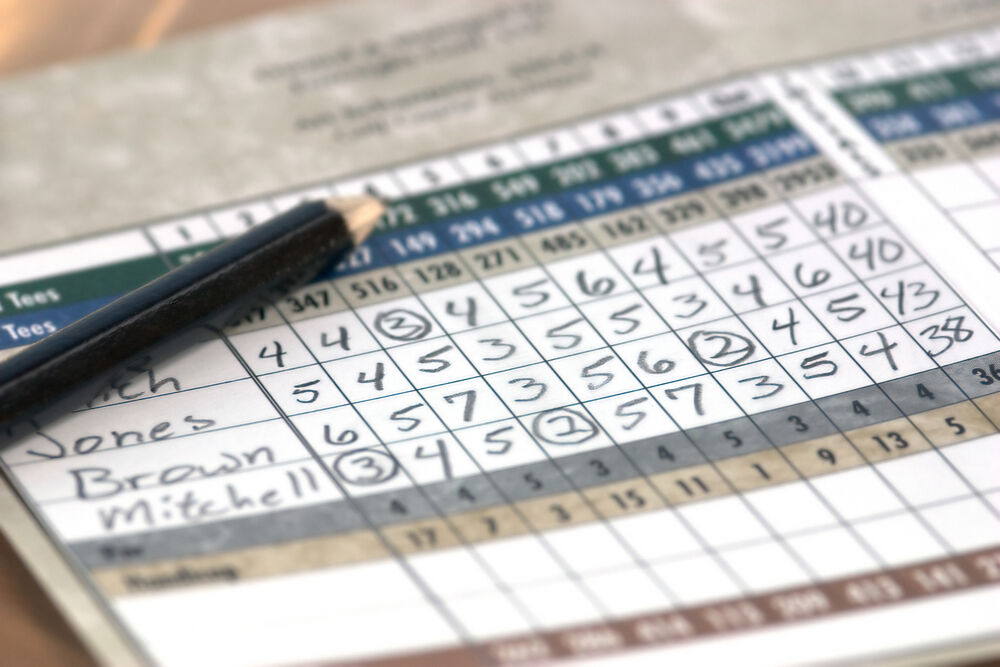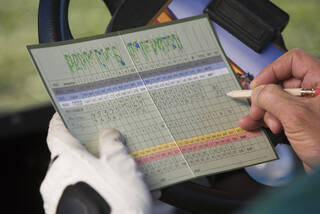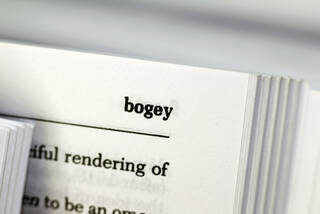Golf Handicaps 101 & How to Know if Yours is Good
A simple guide to golf handicaps plus what qualifies as a "good" handicap

Handicaps in golf can cause confusion. We’re here to clear it up.
Picture this: You step up to the first tee and smoke a drive 270 yards down the fairway. Your opponent then launches a moonshot that starts left, then slices all the way to the right rough, where it settles about 50 yards short of yours.
Without handicaps, your opponent could be in for a long day, but when you learn you’re giving him 12 strokes, the playing field is suddenly leveled.
Your golf handicap is what makes this level playing field possible.
What Is a Golf Handicap?
A golf handicap is a number that represents a player’s potential ability. For example, a player with a course handicap of 3 has the potential to play that course in 3-over par on an above-average day, or roughly 20% of the time.
Golf handicaps are used to allow players of all abilities to compete against each other on a level playing field.
The lower a player’s handicap, the better that player is.
Golf Handicap Definitions
We mentioned that handicaps can cause confusion, and some of the terminology is to blame. For example, a player’s course handicap is different from their handicap index, and their score for a round, their adjusted score, and their scoring differential are all different ways of evaluating how well they played on a given day, and they all factor into the handicap in some way.
Before we go any further, let’s clear them all up.
Adjusted Score: Before entering your scores into the formula above, you must adjust any scores greater than net double bogey (double bogey plus any handicap strokes received on the hole), or quadruple bogey if you don’t already have a handicap established. It’s your adjusted score that you enter into the formula, which limits the damage one or two bad holes can do to your handicap.
Course Handicap: A player’s course handicap is the number of handicap strokes, expressed as a whole number, the player gets on a specific course from a specific set of tees given their handicap index and the difficulty of the golf course.
Handicap Index: A handicap index is a measurement of a golfer’s potential ability.
Differential: A differential is the difference between an 18-hole adjusted score compared to the difficulty of the golf course. Rather than simply subtracting the par of the course from a player’s score, the handicap system factors in the difficulty of the course by churning out an 18-hole differential for every 18-hole score, which is used to calculate a player’s handicap.

Golf Slope Rating Explained in Easy Terms
What’s a Good Handicap?
The average handicap index of male golfers is 14.2, while the average for women is 28.7. That means that men with a handicap better than 14.2 are above average, and any handicap in the single digits is generally considered pretty good.
Men with a handicap index under 5.0 fall into the 90th percentile, and less than two percent of male golfers who keep a handicap have an index 0.0 or better. Meanwhile, women who play to a handicap index of 14.0 or better are in the 90th percentile.

Scratch Golfer FAQs: Behind the Term + Practical Tips
How to Calculate a Golf Handicap
Your golf handicap is the average of the eight lowest differentials out of your last 20 rounds. Here’s how to find your differential for each round, and how to calculate your handicap with fewer than 20 rounds:
- Differential=(adjusted score - course rating) x (113/slope rating)
Eventually, your handicap index will be an average of the lowest eight of your last 20 18-hole differentials, but until you have entered 20 rounds, use the following scale to determine to calculate your handicap using the differentials you have.
- 3 rounds: lowest differential adjusted by -2.0
- 4 rounds: lowest differential adjusted by -1.0
- 5 rounds: lowest differential
- 6 rounds: average of two lowest differentials adjusted by -1.0
- 7-8 rounds: average of two lowest differentials
- 9-11 rounds: average of three lowest differentials
- 12-14 rounds: average of four lowest differentials
- 15-16 rounds: average of five lowest differentials
- 17-18 rounds: average of six lowest differentials
- 19 rounds: average of seven lowest differentials
- 20 rounds: average of eight lowest differentials
Only recently, starting in 2024, the USGA gave players the ability to post 9-hole scores and get an 18-hole differential applied to their handicap right away. However, the USGA has never published the formula it uses to convert 9-hole scores into 18-hole differentials, so you can’t calculate that at home the same way the official system does.
The USGA notes “when a player posts a 9-hole score the WHS (World Handicap System) will automatically calculate an 18-hole Score Differential for the round, based on the player’s 9-hole Score Differential and expected Score Differential based on their current Handicap Index.”

Complete Dictionary of Golf Terms: 200+ Golf Definitions
How To Use Handicap Strokes
Once you and your playing partners have handicaps established, you can play competitive rounds amongst yourselves on a level playing field. But simply using your handicap index isn’t quite enough. Here’s how to use handicap strokes.
First, your handicap index needs to be converted into a course handicap, which factors in things like the difficulty of the course, which set of tees you’re playing, and the fact that players can only give each other full strokes, not tenths of strokes.
The GHIN app, which you should use if you keep an official handicap with the USGA, will spit out your course handicap when you give it the course details.
Use course handicaps to determine how many strokes each player gets, then use the scorecard to determine which holes each player gets strokes.
The scorecard shows the hole rank, 1-18, of every hole on the course. If you get two strokes from your opponent, you’ll get them on the No. 1 and No. 2 (the two most difficult) ranked holes on the course.

Reading a Golf Scorecard in 8 Easy Steps
How To Get a Handicap?
You can get your handicap at your local golf course. Most courses have a tablet or computer devoted to handicap sign-up and score entry.
If you don’t have a home course or belong to a golf club, you can get an official handicap online through the USGA. Visit the USGA’s Get a Handicap page, input your location to find your state golf association, and sign up.
The cost of keeping an official handicap can vary but is generally around $40-75 per year.
Compete Against Others and Yourself
When you finally have your handicap index, it's important to remember it doesn't reflect your average score, but your best potential for a round.
When you consider that your handicap is the average of your best eight rounds of your last 20, you realize that you really only play to that level or better about once every five rounds.
Keeping a handicap index helps you compete against any other golfer, but it’s also a great way to compete against yourself, track your progress, and benchmark your goals.